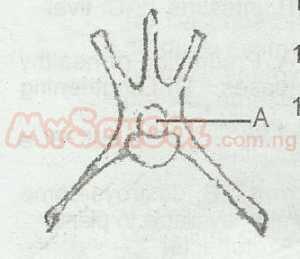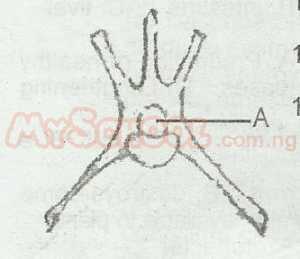Year :
1990
Title :
Biology
Exam :
WASSCE/WAEC MAY/JUNE
Paper 1 | Objectives
11 - 20 of 60 Questions
| # | Question | Ans |
|---|---|---|
| 11. |
Which of the following is not a function of the mammalian skeleton? It A. gives the body its shape B. provides a framework on which internal organs are suspended C. protects soft and delicate parts of the body D. provides attachment for muscles E. contracts and relaxes to bring about movement Detailed SolutionThe four primary functions of the skeletal system are to support muscles and tissue, protect the vital organs, allow movement of bones and muscles and serve as the storage center for immature blood cells and minerals. |
|
| 12. |
 What type of vertebra is represented in the diagram? A. Atlas B. Axis C. Cervical vertebra D. Sacrum E. Lumbar vertebra |
E |
| 13. |
 The structure labelled A represents the A. transverse process B. neural spine C. neural canal D. centrum E. metapophysis |
C |
| 14. |
Which of the following statements is not correct about the functions of each group A. Cervical vertebrae support the neck B. Thoracic vertebrae articulate with the ribs C. Lumbar vertebrae provide attachment for abdominal muscles D. Sacral vertebrae support the skull and allow nodding and rotating movements E. Caudal vertebrae support the tail and provide attachment for tail muscle |
D |
| 15. |
The stems of young herbaceous plants are kept upright mainly by A. osmotic pressure B. turgor pressure C. transpiration pull D. suction pressure E. root pressure. |
B |
| 16. |
Different tissues in plants contribute to the support of the parts as a result of the following characteristics A. malleability B. rigidity C. flexibility D. resilience E. hardness |
A |
| 17. |
Water vapour is lost in plants during transpiration through A. stomata and lenticels B. xylem and stomata C. sclerenchyma and stomata D. parenchyma and lenticels E. guard cells and lenticels |
A |
| 18. |
Gaseous exchange takes place in the adult toad through the A. buccal cavity, bladder and lungs B. buccal cavity, skin and lungs C. tympanic membrane, lungs and gills D. buccal cavity, skin and spiracle E. gills skin and buccal cavity Detailed SolutionThe toads breathe through their mouth, skin and lungs. The mouth cavity is also referred to as the buccal cavity. |
|
| 19. |
Breathing movement in mammals is accompanied by regular movements of the diaphragm and the A. intercostal muscles B. vertebral column C. clavicle D. pleural cavity E. floating ribs |
A |
| 20. |
Which of the following are components of glomerular filtrate? A. All the components of Blood except mineral salts B. Water and salt only C. All the components of blood except plasma protein and cells D. Plasma proteins, red and white blood cells E. Blood cells, amino acid, salts and nitrogenous wastes. |
C |
| 11. |
Which of the following is not a function of the mammalian skeleton? It A. gives the body its shape B. provides a framework on which internal organs are suspended C. protects soft and delicate parts of the body D. provides attachment for muscles E. contracts and relaxes to bring about movement Detailed SolutionThe four primary functions of the skeletal system are to support muscles and tissue, protect the vital organs, allow movement of bones and muscles and serve as the storage center for immature blood cells and minerals. |
|
| 12. |
 What type of vertebra is represented in the diagram? A. Atlas B. Axis C. Cervical vertebra D. Sacrum E. Lumbar vertebra |
E |
| 13. |
 The structure labelled A represents the A. transverse process B. neural spine C. neural canal D. centrum E. metapophysis |
C |
| 14. |
Which of the following statements is not correct about the functions of each group A. Cervical vertebrae support the neck B. Thoracic vertebrae articulate with the ribs C. Lumbar vertebrae provide attachment for abdominal muscles D. Sacral vertebrae support the skull and allow nodding and rotating movements E. Caudal vertebrae support the tail and provide attachment for tail muscle |
D |
| 15. |
The stems of young herbaceous plants are kept upright mainly by A. osmotic pressure B. turgor pressure C. transpiration pull D. suction pressure E. root pressure. |
B |
| 16. |
Different tissues in plants contribute to the support of the parts as a result of the following characteristics A. malleability B. rigidity C. flexibility D. resilience E. hardness |
A |
| 17. |
Water vapour is lost in plants during transpiration through A. stomata and lenticels B. xylem and stomata C. sclerenchyma and stomata D. parenchyma and lenticels E. guard cells and lenticels |
A |
| 18. |
Gaseous exchange takes place in the adult toad through the A. buccal cavity, bladder and lungs B. buccal cavity, skin and lungs C. tympanic membrane, lungs and gills D. buccal cavity, skin and spiracle E. gills skin and buccal cavity Detailed SolutionThe toads breathe through their mouth, skin and lungs. The mouth cavity is also referred to as the buccal cavity. |
|
| 19. |
Breathing movement in mammals is accompanied by regular movements of the diaphragm and the A. intercostal muscles B. vertebral column C. clavicle D. pleural cavity E. floating ribs |
A |
| 20. |
Which of the following are components of glomerular filtrate? A. All the components of Blood except mineral salts B. Water and salt only C. All the components of blood except plasma protein and cells D. Plasma proteins, red and white blood cells E. Blood cells, amino acid, salts and nitrogenous wastes. |
C |